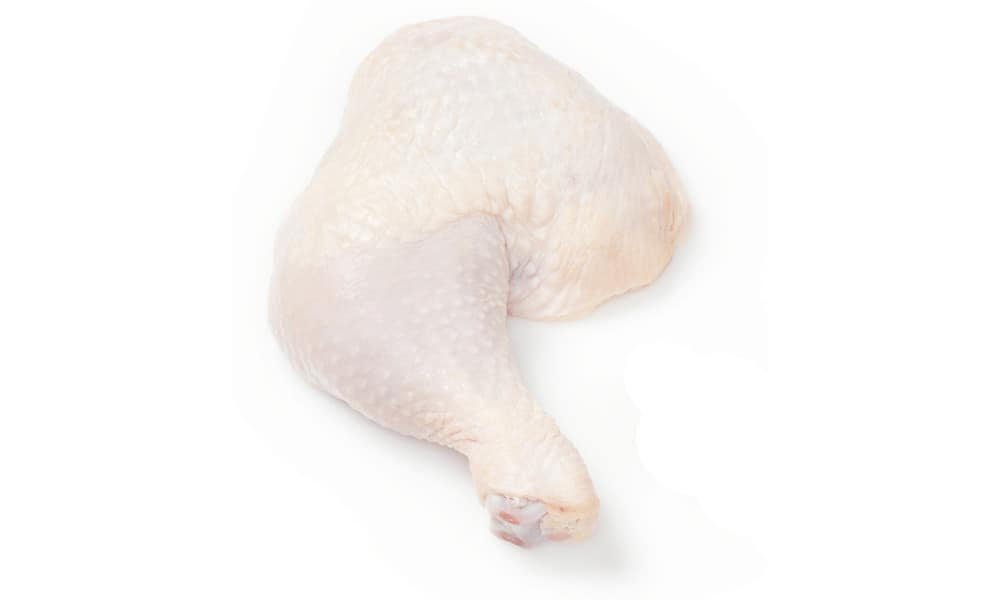If a recipe calls for a certain cut of chicken, you might feel tempted to use whatever chicken pieces you have in the fridge or freezer. Although you may be able to make it work, each part of the chicken does have significant differences when it comes to cooking which can impact the dish.
For example, if the recipe calls for chicken legs but you only use drumsticks, then it could come out overdone or lacking flavor. When it comes to a chicken leg, a chicken drumstick, and a chicken thigh there are some vital differences.
Chicken leg vs. drumstick vs. thigh: here are the main differences that will help you cook smarter in the kitchen.
Chicken Leg Vs. Drumstick
You may hear the terms chicken leg and chicken drumstick used interchangeably. But, they are actually different cuts of the chicken leg quarter, and do have some key differences to be aware of.
The chicken leg refers to the entire leg quarter of the chicken, including the thigh and drumstick. When you slice the chicken leg into two pieces through the joint, you have left with the top half being the chicken thigh, and the bottom part being the chicken drumstick.
Most people prefer drumsticks for quick, casual dishes like fried chicken because they don’t require as much cooking time, and still contain a good amount of meat and fat. Plus, the drumstick bone makes them easy to hold and eat. Because they are normally the preferred cut of chicken rather than the whole chicken leg, they do tend to be a bit more expensive.
The whole chicken leg contains both the thigh and drumstick, and makes for a much meatier and succulent cut of chicken. A chicken leg is the preferred cut of chicken when it comes to roasting or slow cooking. This is because it contains much more fat due to having the thigh attached, which helps keep the chicken moist and delicious while it cooks.
Both cuts of chicken are highly delicious, but knowing when to use the whole chicken leg or just the chicken drumstick will make a huge difference to the dish as a whole.
Whole Chicken Leg Quarter

While some recipes use the terms “drumstick” and “chicken leg” interchangeably, the chicken leg is actually the entire leg with the thigh and drumstick combined. Some recipes call it a chicken quarter because when you cut down a whole chicken into pieces, you are left with four quarters, two legs and two breast quarters, which contain the chicken wing.
Whole chicken quarters have bone, muscle, fat, cartilage, and connective tissues. Different preparation methods affect the meat’s taste, texture, and tenderness. Since quarters are larger than drumsticks, they are perfect to have one per person, in meals like stewed or roast chicken, and grilled chicken.
Cooking a whole chicken leg quarter may take a bit more time than the thigh or drumstick separately, but it will provide you with a much more filling, and well-balanced meal. It’s perfect for keto dishes, and it provides you with protein, omega 3 fatty acids, and various healthy vitamins and minerals. Your quarters can be baked, fried, stewed, boiled, grilled, or even barbecued and smothered in sauce.
Chicken Drumstick Portion

Drumsticks are the lower half of the leg, connecting to the thigh of the chicken by one large joint. Since they’re small and conveniently have the bone attached, drumsticks are great for fried chicken, chicken lollipops, or baked chicken drumstick. Buffets, barbecues, and casual dinners typically involve a large order of drumsticks. They’re so versatile that they work with virtually any sauce and seasoning.
Since drumsticks have a good amount of fat on them they provide amazing flavor. When slow-cooked in rice dishes the meat will literally be falling off the bone. However, you’ll also find them in soups, curries, and stews. Drumsticks are suitable for keto dishes due to their high fat and protein content.
If you’re serving fried chicken or another type of “finger food,” leave the bone in so your guests can easily pick up the chicken. Otherwise, slice it off the bone to make shredded chicken for tacos, sandwiches, salads, or quesadillas.
Chicken Thigh Portion

Chicken thighs are the upper part of the chicken leg. Unlike drumsticks, you’ll need a knife and fork to eat chicken thighs as there’s no bone to grab onto. Since thighs have only a single small bone, you can remove the bone without affecting the texture of the meat. Most chicken thighs at the grocery store are already deboned for convenience, otherwise, they can be quite tricky to eat.
Due to their larger size, cooks typically grill, boil, and stew chicken thighs. They also give you plenty of shredded chicken for tacos, sandwiches, and other recipes. Chicken thighs are essentially a blank palette that responds to a variety of sauces and seasonings – but are much more tender and succulent than breast.
Contrary to popular belief, dark meat isn’t unhealthier than white meat. In fact, dark meat from the thigh has more of some nutrients like protein and iron than white meat. However, chicken breast is still more popular than chicken thighs, but this means you can pick up chicken thighs for a cheaper, and more tasty alternative anyway!
Cooking With Chicken Leg vs. Drumsticks and Thighs
Chicken legs, thighs, and drumsticks have similar cooking times, with drumsticks taking 30 minutes, thighs taking 30 minutes, and chicken leg quarters taking up to 45 minutes. To roast the chicken, preheat the oven to 350 degrees Fahrenheit, then season the chicken handsomely, add a dash of olive oil, and place it in the oven.
Make sure the chicken reaches internal temperatures of 165 degrees Fahrenheit before serving, as this is considered the safe internal temperature for chicken.
When the juice is clear in the deepest part of the cooked chicken and around the bones you know that the chicken is ready to eat. Store leftover meat in the fridge or freezer no longer than two hours after it’s been cooked, as otherwise, you risk bacteria growing on it.
If you are health conscious you can remove the skin after cooking. Don’t remove it before you roast the chicken–the skin keeps the meat moist and tender. If you remove the skin too early, your meat will dry out. Sometimes you may find little hairs on the chicken skin, don’t worry this is normal and will normally disappear over the cooking period.
Chicken skin contains high percentages of fat and calories, but it does contain a good amount of flavor! If your chicken skin is rubbery, then you need to cook it at a higher temperature!
Lastly, bad-smelling raw chicken doesn’t always mean it’s off! If you’ve just opened the air-tight package and you get a nasty whiff, it’s normally just due to being starved of oxygen for so long. Still, take necessary steps to be sure your chicken has not spoiled.
Chicken Leg, Drumstick, And Thigh Nutrition Differences
According to FatSecret, chicken leg quarters eaten with the skin on contain:
- 200 calories
- 12 grams of fat
- 80mg of cholesterol
- 350mg of sodium
- 24 grams of protein
- 200mg of potassium
- Other nutrients include iron, calcium, and vitamin A
Chicken drumsticks contain a fraction of the nutrients, being much smaller in size too:
- 70 calories
- 3.5 grams of fat
- 30 mg of cholesterol
- 135 mg of sodium
- 8.5 grams of protein
- 75 mg of potassium
Chicken thighs contain:
- 130 calories
- 8 grams of fat
- 50 mg of cholesterol
- 215 mg of sodium
- 14 grams of protein
- 125mg of potassium
All in all, the nutritional differences between each cut of chicken aren’t drastic and are all considered healthy in moderate amounts. Chicken without the skin has lower levels of fat and cholesterol.


